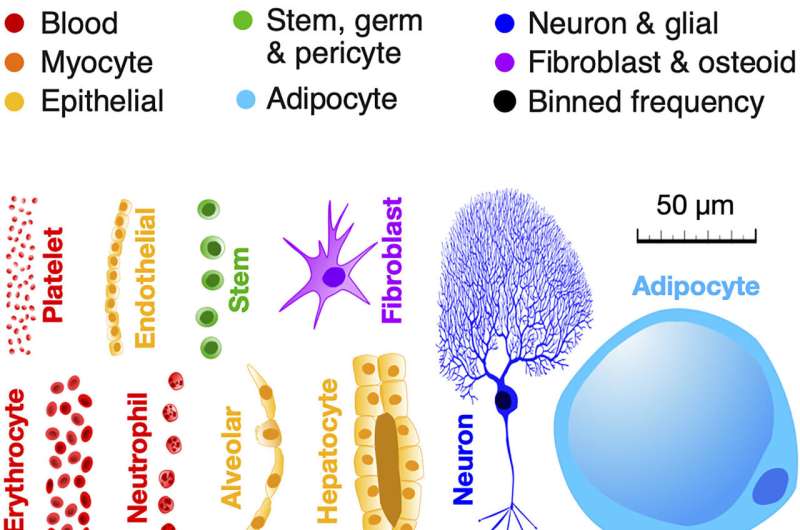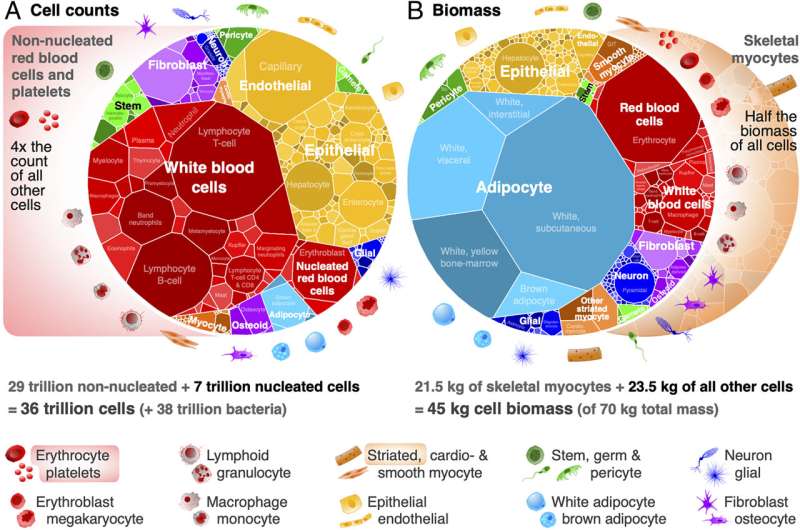September 20, 2023 report
This article has been reviewed according to Science X's editorial process and policies. Editors have highlighted the following attributes while ensuring the content's credibility:
fact-checked
peer-reviewed publication
trusted source
proofread
Common statistical principles of scaling found in nature now seen in human cells

Research led by the Department of Earth and Planetary Sciences, McGill University, Canada, has found that human cells seem to follow a homeostasis pattern of cell size and count across the entire organism.
In a paper, "The human cell count and size distribution," published in Proceedings of the National Academy of Sciences, the researchers unveil a mystery of mathematical symmetry across human cell tissue types, hinting at an unknown developmental mechanism that seems to follow a structured course commonly seen in nature.
The intriguing discovery is of an inverse relationship between cell size and count. As cell size increases, the cell count decreases and vice versa so that cells within a given logarithmic size class contribute equally to the body's total cellular biomass. The study reveals that this relationship holds across various cell types and size classes, suggesting a trade-off between these variables.
Cell size and count are essential factors in the human body's growth and function. Until now, no study has examined the relationship between cell size and count across the entire human organism. The team compiled a comprehensive dataset of cell size and count across major cell types, drawing from over 1,500 published sources.
The data reveals estimated total body cell counts of approximately 36 trillion cells for a male, 28 trillion cells in females, and 17 trillion cells in a child of ten years old. The distribution of cell biomass in the human body is dominated by muscle and fat cells, while red blood cells, platelets, and white blood cells largely influence cell counts. Each cell type typically maintains a characteristic size range, which is uniform throughout an individual's development, and the same holds across mammalian species.

The authors point out that "...despite the uniformity in size of any given cell type, cell sizes vary over an enormous seven orders of magnitude from red blood cells to the largest muscle fibers, comparable to the mass ratio of a shrew to a blue whale," with differences exceeding a million-fold.
Whether the size distribution of cells across the entire human body follows a lognormal distribution, similar to that of a single cell type, or if other distributions are favored and by what mechanism this would be controlled is unclear.
The observed patterns of an inverse relationship between cell size and count are similar to Zipf's law and Taylor's law, statistical principles of scaling that are recurrent across nature in everything from the distribution of bacteria in the soil to the population of fish in the ocean and is even found in linguistic word use and music.
Zipf's law describes a power-law distribution where a small number of elements account for the majority of occurrences in a dataset. The inverse relationship between cell size and cell count is reminiscent of Zipf's law because a small number of very large cells (in terms of size) account for a significant portion of cell biomass, while numerous smaller cells contribute to the overall cell count.
Taylor's law states that the variance in the number of individuals (or some other measurement) within a group scales with the mean of that measurement raised to a certain exponent. Taylor's law is seen in relation to the size and count variations across different cell types. The study finds that the coefficient of variation (CV) in cell size remains approximately constant across cell types, implying that cell mass variance scales with the mean cell mass raised to a certain power.
The patterns suggest recurrent principles in the organization and distribution of cell sizes and counts, both within the human body and in natural systems more broadly. The authors emphasize the importance of a whole-organism perspective in understanding human cell types, especially in the context of initiatives like the Human Cell Atlas.
More information: Ian A. Hatton et al, The human cell count and size distribution, Proceedings of the National Academy of Sciences (2023). DOI: 10.1073/pnas.2303077120
Journal information: Proceedings of the National Academy of Sciences
© 2023 Science X Network




















